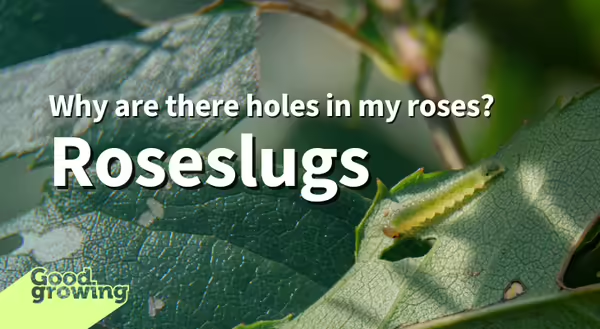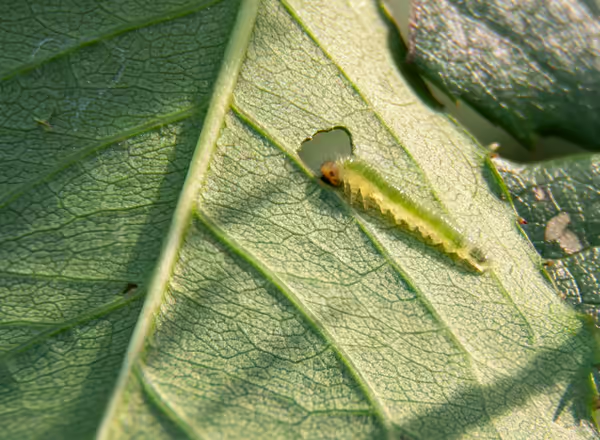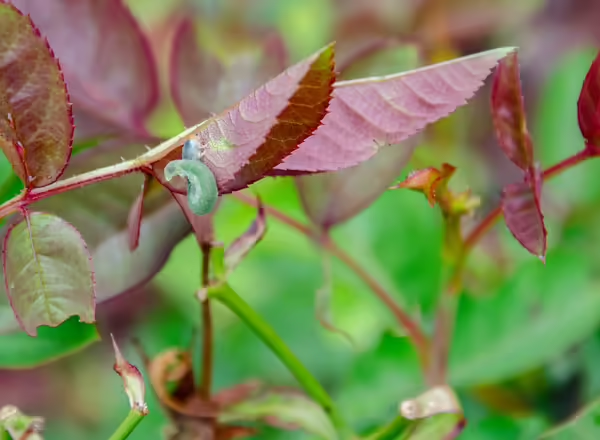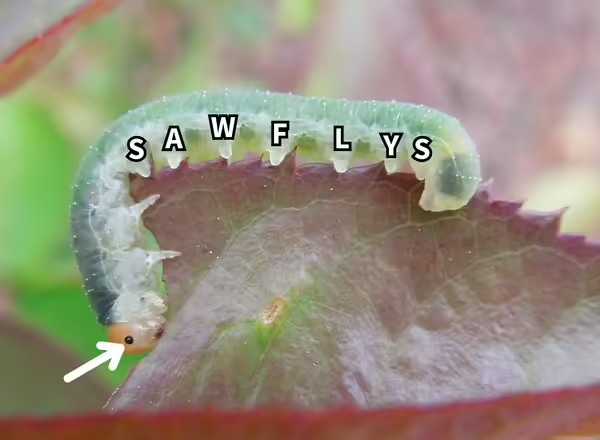
Roses are grown in many gardens for their large, showy, often fragrant flowers. If you grow roses, you may have noticed something eating the leaves of your plants, causing them to become unsightly. While Japanese beetles often get much of the blame during the summer months, they aren’t the only insects that will feed on the foliage of roses. Roseslugs can also frequently be found feeding on and damaging rose leaves.
What are roseslugs?
Roseslugs are caterpillar-like insects. Three different species of roseslugs can be found in Illinois: the European roseslug (Endelomyia aethiops), the curled rose sawfly (Allantus cinctus), and the bristly roseslug (Cladius difformis).
Despite their common name and appearance, they are neither slugs nor caterpillars but rather sawflies. Sawflies are related to bees, ants, and wasps (Hymenoptera) and are often considered pests because they feed on plants. Sawflies get their common name from their saw-like ovipositor (egg-laying structure) that they will use to cut slits into the stems or leaves of plants to lay their eggs.
Life cycle and damage
European roseslug larvae are light green with orange heads and will grow to be about ½ inch long. They feed on the upper surfaces of leaves, leaving behind the veins and lower leaf surface from May through June. When they are done feeding, they will leave the plant and pupate in the ground, where they will remain until the following spring (one generation per year). The adults will emerge in spring, and eggs will be laid in pockets near the edges of leaves.
Curled rose sawflies are green with white spots and have yellow heads with a dark stripe down the middle. They will grow to be around ¾ inch long. When small, they will skeletonize leaves and, as they grow larger, will eventually eat the entire leaf except for the main leaf vein. In addition to their feeding damage, when they pupate, they will bore into twigs, particularly those that have been pruned, which can further damage plants. They will often curl up when resting, thus their common name. There are two generations per year.
Bristly roseslugs are green, with fine, hairlike spines, and grow to about ½ inch long. When small, they will feed on the undersides, causing them to have windowpane-like damage (the upper leaf surface is all that is left). As the larvae get larger, they eat the entire leaf except for large veins. When they are done feeding, they spin a cocoon in plant debris or on the plant themselves. There can be six or more generations per year, meaning they are capable of causing extensive damage, especially towards the end of the growing season. Eggs are laid in the midribs of leaves.



Managing roseslugs
Because European and curled roseslugs are only present early in the growing season, management is usually not necessary. However, because bristly roseslugs are present throughout the growing season, management may be needed if populations become high.
Small infestations can be removed by hand, or a forceful spray of water can be used to knock off and kill small larvae. If you decide to use water, make sure you spray both the upper and undersides of the leaves.
If populations become too high, insecticides can also be used to manage populations. Remember, despite looking like caterpillars, they are closely related to bees, ants, and wasps (Hymenoptera). So insecticides, like Bacillus thuringiensis kurstaki (Btk), that only work on caterpillars (Lepidoptera) will not affect these insects. Some insecticides containing horticultural oil, insecticidal soaps, acephate, bifenthrin, carbaryl, and cyfluthrin, can be used to manage roseslugs.
If you decide to use pesticides, read and follow all label directions. While many roses have limited (if any) pollen and nectar available to pollinators, some single-flowered types may. Make sure you avoid getting insecticides on flowers; anything that will kill roseslugs will likely kill pollinators too.

Good Growing Fact of the Week: Not sure if you have a sawfly or a caterpillar? There are a few ways you can tell them apart:
- The eyes of caterpillars are very small and difficult to see, while sawflies have relatively large eyes that can easily be seen.
- Caterpillars have five or fewer pairs of prolegs (fleshy structures on the abdomens that look and act like legs), while sawflies have six or more pairs. An easy way to remember this is that they have enough to spell ‘sawfly.’
Resources and for more information
Johnson, Warren T, and Howard H Lyon. 1976. Insects That Feed on Trees and Shrubs.
Middleton, William, 1893-. Sawflies injurious to rose foliage., book, 1940; Washington D.C.. (https://digital.library.unt.edu/ark:/67531/metadc6487/: accessed June 4, 2024), University of North Texas Libraries, UNT Digital Library, https://digital.library.unt.edu; crediting UNT Libraries Government Documents Department.
Photos by Ken Johnson, University of Illinois Extension
Want to get notified when new Good Growing posts are available? SIGN ME UP!
Give us feedback! How helpful was this information (click one): Very helpful | Somewhat helpful | Not very helpful
MEET THE AUTHOR
Ken Johnson is a Horticulture Educator with University of Illinois Extension, serving Calhoun, Cass, Greene, Morgan, and Scott counties since 2013. Ken provides horticulture programming with an emphasis on fruit and vegetable production, pest management, and beneficial insects. Through his programming, he aims to increase backyard food production and foster a greater appreciation of insects.